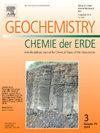Pan-African eclogite-facies tectonic mélange in the Egéré area, Tuareg Shield (Algeria): Integrated approaches for lithological and structural mapping
IF 2.9
3区 地球科学
Q2 GEOCHEMISTRY & GEOPHYSICS
引用次数: 0
Abstract
The Tuareg Shield is made up of 25 terranes separated by extensive shear zones that are several hundred km-long, which have been attributed to a northward post-collisional tectonic escape during the Pan-African orogeny. The development of these shear zones was accompanied by abundant high-K calc-alkaline batholiths and plutons (~630–580 Ma). In the northern Egéré-Aleksod terrane of Central Hoggar (LATEA metacraton), the Egéré area exhibits minimal Pan-African magmatism, preserving earlier tectonic events such as subduction, collision, and terrane exhumation. The Egéré region consists of a parautochthonous amphibolite-facies unit (Arechchoum Group) and three eclogite-facies nappe units (Lower Egéré, Upper Egéré, and Oneral groups). These were thrust over the Archean Amadror cratonic core after the subduction of the LATEA passive margin superstructure to which they belong. These units have Paleoproterozoic protoliths, predominantly magmatic in the Arechchoum Group, or mixed magmatic and sedimentary in the Egéré Group, while the Oneral Group, which forms the uppermost nappe, comprise Neoproterozoic sediments.
Space-borne imagery data are used to map the eclogitic layers, integrated with magnetic and gravity surveys to delineate major shear and thrust zones. In addition, 2D modelling of magnetic and gravity data was used to investigate the upper crust, revealing a Pan-African granitic batholith and a large ultramafic-mafic bod at depth. The results allowed detailed geological mapping of such a complex tectonic mélange belonging to both lower and upper plate segments. Integrated with the published geochronological data, this mélange includes rocks with Rhyacian to Statherian, Calymmian, and Early Cryogenian ages, all of which underwent Late Cryogenian high-pressure metamorphism, followed by Ediacaran high-temperature metamorphism and tectonic escape processes.
Our results reveal the complex tectonic evolution of a former passive margin that was subducted to great depths during the Pan-African orogeny. The preservation of early subduction and exhumation events provides key insights into tectonometamorphic processes and deep crustal evolution in this high-pressure metamorphic terrane.
图阿雷格盾(阿尔及利亚)eg区域泛非榴辉岩相构造剖面:岩性和构造制图的综合方法
图阿雷格地盾由25个地被数百公里长的广泛剪切带分隔开的地体组成,这被归因于泛非造山运动期间向北的碰撞后构造逃逸。这些剪切带的发育伴随着丰富的高钾钙碱性岩基和岩体(~630 ~ 580 Ma)。在中Hoggar的egsamrs - aleksod地体(LATEA)北部,egsamrs区域显示出最小的泛非岩浆活动,保留了早期的构造事件,如俯冲、碰撞和地体挖掘。该地区由一个准原生角闪岩相单元(Arechchoum群)和三个榴辉岩相推覆体单元(下egsamr组、上egsamr组和Oneral组)组成。它们是在其所属的LATEA被动边缘上部构造俯冲后,在太古宙阿玛德罗克拉通岩心上逆冲而成的。这些单元有古元古代的原岩,在Arechchoum群中以岩浆为主,或在eg r群中以岩浆和沉积混合为主,而形成最上层推覆体的ongeneral群则由新元古代的沉积物组成。利用星载图像数据绘制榴辉岩层图,并结合磁场和重力测量来圈定主要剪切和逆冲带。此外,利用磁性和重力数据的二维建模对上地壳进行了研究,揭示了泛非花岗岩基和深度的大型超镁铁质-基性体。这一结果使得对这样一个既属于下板块又属于上板块的复杂构造范围进行了详细的地质测绘。结合已发表的地质年代学资料,该范围包括了早冷世、晚冷世、晚冷世高压变质、埃迪卡拉纪高温变质和构造逃逸作用。研究结果揭示了泛非造山运动时期前被动边缘俯冲至深部的复杂构造演化过程。早期俯冲和掘出事件的保存为了解高压变质地体的构造变质过程和深部地壳演化提供了关键的见解。
本文章由计算机程序翻译,如有差异,请以英文原文为准。
求助全文
约1分钟内获得全文
求助全文
来源期刊

Chemie Der Erde-Geochemistry
地学-地球化学与地球物理
CiteScore
7.10
自引率
0.00%
发文量
40
审稿时长
3.0 months
期刊介绍:
GEOCHEMISTRY was founded as Chemie der Erde 1914 in Jena, and, hence, is one of the oldest journals for geochemistry-related topics.
GEOCHEMISTRY (formerly Chemie der Erde / Geochemistry) publishes original research papers, short communications, reviews of selected topics, and high-class invited review articles addressed at broad geosciences audience. Publications dealing with interdisciplinary questions are particularly welcome. Young scientists are especially encouraged to submit their work. Contributions will be published exclusively in English. The journal, through very personalized consultation and its worldwide distribution, offers entry into the world of international scientific communication, and promotes interdisciplinary discussion on chemical problems in a broad spectrum of geosciences.
The following topics are covered by the expertise of the members of the editorial board (see below):
-cosmochemistry, meteoritics-
igneous, metamorphic, and sedimentary petrology-
volcanology-
low & high temperature geochemistry-
experimental - theoretical - field related studies-
mineralogy - crystallography-
environmental geosciences-
archaeometry
 求助内容:
求助内容: 应助结果提醒方式:
应助结果提醒方式:


